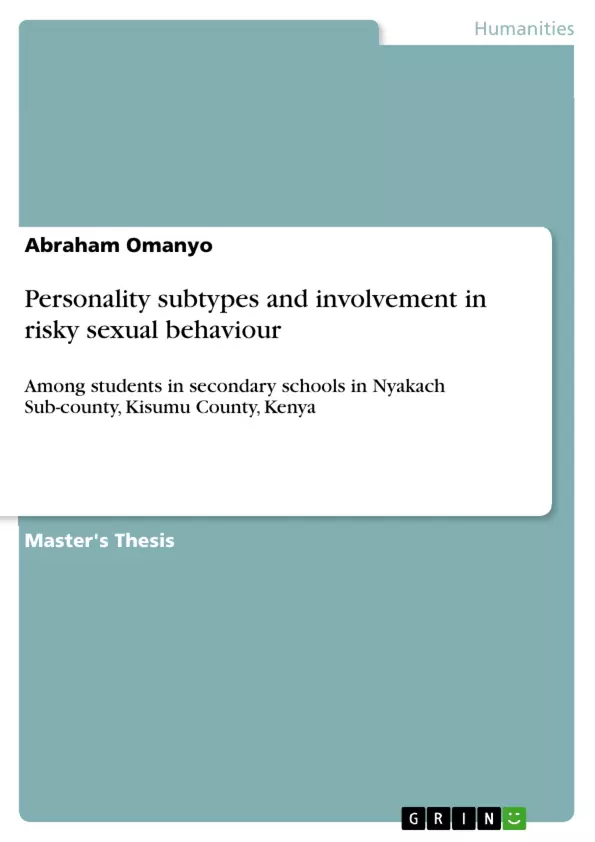Risky sexual behaviour is a common habit among young people in the world, and its relation with personality has not been explored exhaustively, especially in Kenya. The purpose of the study was to establish the relationship between personality sub-types and involvement in risky sexual behaviour among secondary school students in Nyakach Sub-county, Kisumu County, Kenya. The study was guided by the following research objectives; to establish the relationship between introversive personality subtype and involvement in risky sexual behaviour; to find out the relationship between extroversive personality subtype and involvement in risky sexual behaviour; to determine the relationship between the neurotic personality subtype and involvement in risky sexual behaviour and to investigate the relationship between the Psychoticism and involvement in risky sexual behavior. The study was informed by two theories that is, the Eysenck’s Theory of personality and the Theory of Planned Behavior. The research design used in this study was the Correlational research design. The sample size of this study was 46 schools representing 88% of the target population. As for the students, 390 students were sampled from total target population 15,678. This study used multistage random sampling to select the schools and students. Quantitative data was collected using Eysenck’s Personality Questionnaire (EPQ) and Risky Sexual Behaviour Questionnaires. Quantitative data was analyzed using descriptive statistics (frequency, percentages and mean) as well as inferential statistics (Pearson Correlation and multiple regressions). The major findings of the study showed relationship between personality sub-types and involvement in risky sexual behaviour (for introversion r=-0.439, extroversion r=0.786, neuroticism r=-0.410 and Psychoticism r=0.025). Multiple regression at R2=0.679 showing that personality subtypes are significant predicators of involvement in risky sexual behaviour at 67.9%. Reliability of questionnaires was obtained through internal consistency with cronbach’s constant at 0.632.The study recommended that the Ministry of Education should develop working guidelines to educate and mould the students in a way that they reduce their risk of engaging in risky sexual behaviour. [...]
Inhaltsverzeichnis (Table of Contents)
- CHAPTER ONE: INTRODUCTION
- 1.1 Background of the Study
- 1.2 Statement of the Problem
- 1.3 Purpose of the Study
- 1.4 Objectives of the Study
- 1.5 Research Questions
- 1.6 Significance of the Study
- 1.7 Scope of the Study
- 1.8 Limitations of the Study
- 1.9 Definition of Terms
- CHAPTER TWO: LITERATURE REVIEW
- 2.1 Introduction
- 2.2 Risky Sexual Behaviour
- 2.3 Personality
- 2.4 Relationship between Personality Subtypes and Risky Sexual Behaviour
- 2.5 Theoretical Framework
- 2.6 Conceptual Framework
- 2.7 Summary
- CHAPTER THREE: RESEARCH METHODOLOGY
- 3.1 Introduction
- 3.2 Research Design
- 3.3 Population of the Study
- 3.4 Sample Size and Sampling Techniques
- 3.5 Instruments of Data Collection
- 3.6 Data Collection Procedures
- 3.7 Data Analysis Procedures
- CHAPTER FOUR: DATA PRESENTATION, ANALYSIS AND INTERPRETATION
- 4.1 Introduction
- 4.2 Demographic Characteristics of the Respondents
- 4.3 Relationship between Personality Subtypes and Involvement in Risky Sexual Behaviour
- CHAPTER FIVE: DISCUSSION, CONCLUSIONS AND RECOMMENDATIONS
- 5.1 Introduction
- 5.2 Discussion of Findings
- 5.3 Conclusions
- 5.4 Recommendations
- REFERENCES
- APPENDICES
Zielsetzung und Themenschwerpunkte (Objectives and Key Themes)
This study aims to understand the relationship between personality subtypes and involvement in risky sexual behavior among secondary school students in Nyakach Sub-county, Kisumu County, Kenya. It aims to establish if there is a correlation between specific personality traits and the likelihood of engaging in risky sexual behaviors.
- The relationship between personality subtypes and risky sexual behavior.
- The influence of personality on decision-making regarding sexual health.
- The impact of personality on the adoption of safe sex practices.
- The role of personality in understanding the prevalence of risky sexual behavior among secondary school students.
- The implications of personality subtypes for targeted interventions and counseling strategies.
Zusammenfassung der Kapitel (Chapter Summaries)
Chapter One provides an introduction to the study, outlining the background, statement of the problem, purpose, objectives, research questions, significance, scope, limitations, and definition of terms. Chapter Two delves into the literature review, exploring the concepts of risky sexual behavior, personality, and the existing research on their relationship. It also presents the theoretical and conceptual frameworks guiding the study. Chapter Three details the research methodology, outlining the research design, population, sample size, sampling techniques, instruments used, data collection procedures, and data analysis methods. Chapter Four presents the findings of the study, analyzing the data collected and interpreting the relationship between personality subtypes and involvement in risky sexual behavior.
Schlüsselwörter (Keywords)
The primary keywords and focus topics of this research are: personality subtypes, risky sexual behavior, secondary school students, Nyakach Sub-county, Kisumu County, Kenya, Eysenck's Personality Questionnaire (EPQ), Theory of Planned Behavior, correlation, regression analysis.
- Quote paper
- Abraham Omanyo (Author), 2016, Personality subtypes and involvement in risky sexual behaviour, Munich, GRIN Verlag, https://www.grin.com/document/343635



